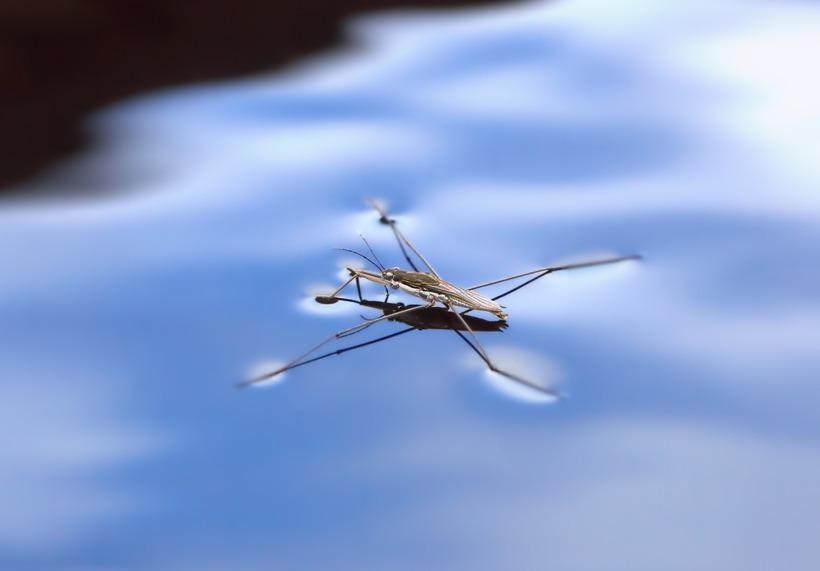Published in the journal Nano Today, researchers have developed water-treading soft machines that can be remotely controlled by light.

Study: Bioinspired light-fueled water-walking soft robots based on liquid crystal network actuators with polymerizable miniaturized gold nanorods. Image Credit: wiklander/Shutterstock.com
Here, researchers coupled an extremely hydrophobic buoyant surface with multi-level nanostructures and light-powered soft actuation legs. This was produced by incorporating polymerizable miniaturized gold nanorods (MiniGNR nanomonomer) on-site in liquid crystal network (LCN)-based soft actuators.
Water-Walking Soft Robots
Inspired by soft-body sea creatures, substantial attempts have been undertaken to develop water-based soft bots that use body-shape-altering mobility to provide exceptional movement capability and mimic functionality.
Compared to traditional robots consisting of stiff elements, water-based soft robots constructed of stimuli-sensitive soft substances do not always depend on joint actuation or synchronized movement of interconnected limbs.
In this context, a variety of soft materials, including hydrogels, shape-memory polymeric materials, and liquid crystal polymers have been used to create water-based soft robots that can be actively driven by various triggers, including light, electric or magnetic field, and biohybrid activation.
Optimizing the Liquid Crystal Network
Light-powered water-treading soft machines are still being researched. Having unlimited controllability, these soft robots need the development of light-powered soft activators with quick photoresponsiveness and excellent actuating effectiveness.
Photoactivators predicated on liquid crystal polymeric complexes, like the liquid crystal network (LCN), should distinguish themselves as some of the most attractive choices in this area owing to their reversible actuating ability and structure changing programmability.
One effective approach for endowing LCN-based soft activators with outstanding photoresponsiveness is to integrate the LCN polymeric matrices with diversified opto-thermal nanomaterials such as carbon-based nanomaterials and metallic nanoparticles, where the on-site heat energy transformed from the absorbed light can stimulate the nematic-to-isotropic or order-disorder phase change of LCN and resulting repairable shape change.
The Use of Gold Nanorods
Gold nanorods (GNRs) have been identified as really prospective optothermal nanoscale agents owing to their exceptional capacity to effectively transform light irradiation into localized heat via a non-radiating relaxing mechanism known as localized surface plasmon resonances (LSPR).
Traditional GNRs-incorporated LCN soft activators have many fundamental shortcomings, including low miscibility in liquid crystal frameworks, a large light energy input demand, and a relatively sluggish photoresponse time.
It is highly desired to produce GNRs-incorporated soft actuators with quick photoresponse and strong actuating capabilities for light-powered water-treading soft robots.
Key Findings of the Study
In this study, biologically inspired water-treading soft bots controllable by light were conceived and built by combining an extremely hydrophobic buoyant surface with multi-layer nanostructures and light-powered soft-actuating legs comprised of MiniGNR-LCN soft activators.
The uniqueness and relevance of the developed soft robots are highlighted by several features. For example, the LCN soft actuators integrated with unique polymerizable MiniGNR nanomonomer display quick photoresponsiveness, serving as sturdy driving limbs to enable effective forward movement on the surface of water.
Incorporating an extremely hydrophobic surface enables the soft machines with weight-carrying and drag-minimizing capability, facilitating fast water-walking mobility.
Finally, the tunable photoresponse of MiniGNR nanomonomer could be implemented for producing omni-directional water-treading soft machines with visible and infrared wavelength-specific controllability.
After cyclic NIR irradiation, the team's single-legged soft robot was able to walk in one direction on the water surface via horizontal momentum transfer of light-induced actuating force to the water. The contact angle of the super-hydrophobic surface was discovered to have a considerable influence on water-treading speed, and high hydrophobicity is critical for a rapid and stable light-powered water-walking process.
The researchers presented a three-legged water walking soft robot that can perform visible and infrared wavelength-reliant omni-directional movements by designing and fabricating MiniGNR-LCN soft actuators with varying photoresponses.
It is noteworthy that the three-legged soft machine could carry out more complicated movements when subjected to combined light irradiations of various wavelengths, since the movement direction and pace of the three-legged soft bot are closely connected to the light-generated actuating force of three moving legs, which is defined by the intensities and wavelengths of respective light sources.
This research might give a new boost in the advancement of unattached water-based soft robots with advanced spatiotemporal activation, which could find varied potential uses in the offshore industry, environmental monitoring, and future ocean exploration.
Reference
Yang, X., et al. (2022). Bioinspired light-fueled water-walking soft robots based on liquid crystal network actuators with polymerizable miniaturized gold nanorods. Nano Today, 43. Available at: https://www.sciencedirect.com/science/article/pii/S1748013222000469?via%3Dihub
Disclaimer: The views expressed here are those of the author expressed in their private capacity and do not necessarily represent the views of AZoM.com Limited T/A AZoNetwork the owner and operator of this website. This disclaimer forms part of the Terms and conditions of use of this website.